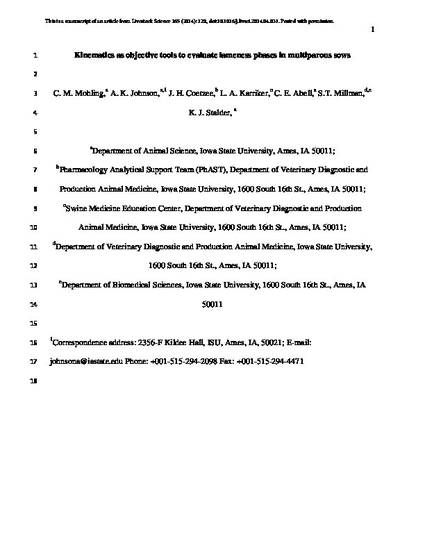
Lameness has been ranked as the third most common reason for culling sows, comprising 15% of the culls marketed in the U.S. Producers assess sow lameness using subjective evaluation, which have been shown to be variable in their application. Objective empirical tools to measure sow lameness on farm are required. Therefore, the purpose of this study were to evaluate the embedded force plate and the GAITFour gait analysis walkway system as objective assessment tools to discriminate between sound and lame phases in multiparous sows. Twenty-four mixed parity crossbred sows were anesthetized and injected with Amphotericin B in the distal interphalangeal joint of both claws of one hind hoof to induce transient lameness. Kinematic data was collected on D−1, D+1 and D+6 relative to induction (D0). For the embedded force plate, weight distributions on each hoof were collected. Gait analysis measures collected were stride time (defined as the time (s) between 2 successive footfalls by the same hoof), stride length (defined as the distance (cm) between 2 sequential footfalls from the same hoof),maximum pressure (defined as the greatest amount of weight (kg/cm2) placed on a single hoof) and stance time (defined as the duration of time (s) the sensors were activated by a hoof in a single stride). For the embedded microcomputer-based force plate system weight placed on the induced hoof decreased on D+1 when compared to D−1 (P® pressure mat gait analysis walkway system, stride time increased on D+1 for all hooves, stride length decreased on D+1 compared to D−1 and maximum pressure placed on the induced hoof decreased on D+1 compared to baseline levels (PStance time increased for all sound hooves on D+1 compared to D−1 (P
Available at: http://works.bepress.com/anna_butters-johnson/66/

NOTICE: this is the author’s version of a work that was accepted for publication in Livestock Science. Changes resulting from the publishing process, such as peer review, editing, corrections, structural formatting, and other quality control mechanisms may not be reflected in this document. Changes may have been made to this work since it was submitted for publication. A definitive version was subsequently published in Livestock Science, 165 (2014), doi: 10.1016/j.livsci.2014.04.031. Posted with permission.